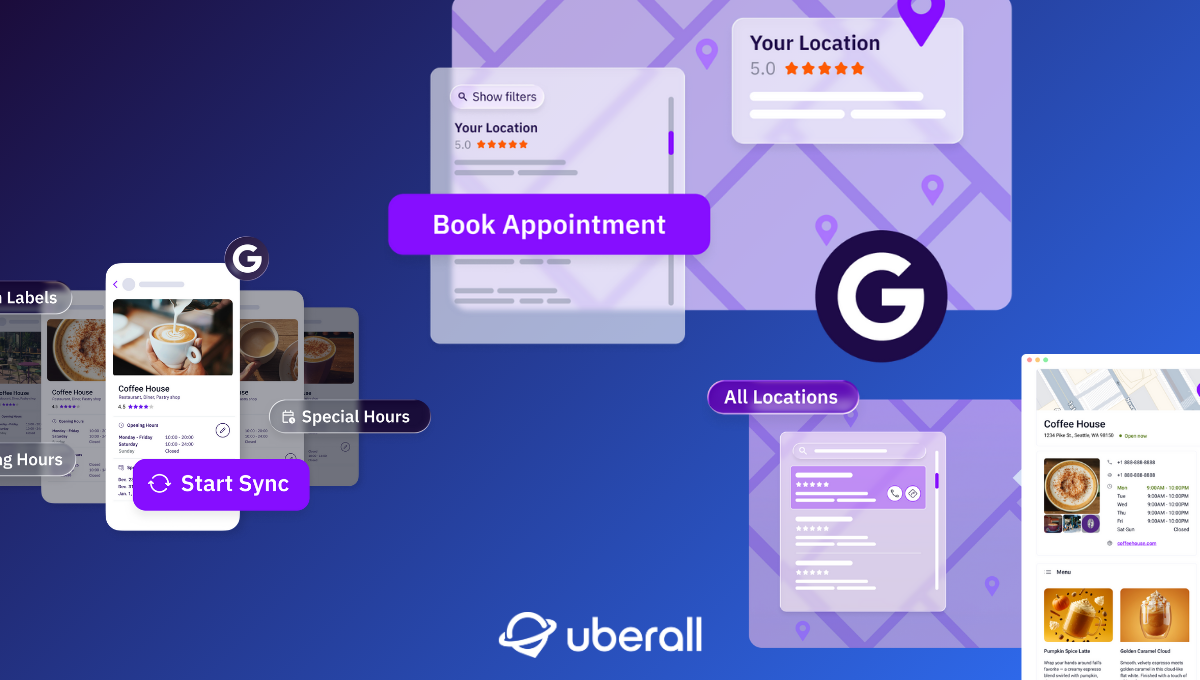
Best Backlinks for Local SEO—And Why You Should Never Buy Backlinks
Local backlinks are pointers for people navigating the internet (towards your business). Here's how you manage backlinks; and how to avoid Google…
Ever meandered around a website and got stuck down a rabbit hole, clicking endlessly on interesting links? Those links do more than facilitate your procrastination. Oftentimes, they function as incredibly important, carefully planned factors in a local SEO strategy.
The so-called “backlinks” simplify the work of navigating the internet, and allow search engines to understand how websites fit in on the broader web; which is why you are better off by knowing what makes for an authoritative backlink. To exploit their potential—and avoid local SEO mistakes—we’re summarizing best practices for you.
What Are Backlinks?
Simply put, backlinks are links on other websites (the “referring site”) that point readers to your website (the “target site”). You might also hear about them under the terms “inbound links”, “incoming links”, or even just “links”. But whatever marketers choose to call them, they enable users to move around the internet and follow up on related topics.
Backlinko describes backlinks as “votes of credibility from other sites”. The more “high-quality” backlinks point back to you, the more likely your website will rank more highly in search results. In fact, they formed the foundation of Google’s original algorithm, known then as PageRank and are one of the most important ranking factors up until today.
What is the difference between backlinks and internal links?
Backlinks are links from external websites pointing to your site while internal links connect pages within your website. Both link types are critical for SEO: backlinks boost domain authority and external visibility, and internal links enhance site structure and user experience. And then there’s external links, also known as outbound links, linking from your website to other websites.
Who Creates Backlinks?
Backlinks are typically created by other websites or individuals who link to your website's content because they find it valuable or relevant. This can happen organically when other website owners reference your content in their articles, blogs, or resources.
In some cases, website owners actively pursue backlinks through outreach efforts, collaborations, or guest posting on other websites. These efforts aim to establish relationships with other site owners and gain links from authoritative sources to improve SEO.
When creating backlinks, website owners may use the "nofollow" attribute to indicate to search engines that they do not endorse the linked content or want to avoid passing on link equity. This can be done to comply with guidelines or to prevent spammy or low-quality links from impacting their own website's SEO performance.
Who Cares about Backlinks?
For something so small and simple, backlinks hold an outsized weight in how search engines determine website authority—in other words: how much they believe your website is relevant for a given search term. Improving website authority improves your chances of appearing first on their search results page.
Backlinks also allow Google to discover, and therefore rank, your content; website crawlers use links to find new pages on the web.
SEO Link Building For Local Businesses
Backlinks management can be a bit of a tricky beast; one which digital marketers in multi-location businesses may struggle to tame without a little help.
You might feel tempted to pay for backlinks or offer to swap links with a local influencer—but that means risking penalties from search engines like Google. Instead, focus on building backlinks for SEO with high-quality, authoritative websites, so search engines see your site’s trustworthiness is deserving of higher ranks in the results they show.
Backlinks Behind the Scenes
Not all backlinks improve SEO—you want to get a “dofollow” link, not a “nofollow” one to support your local citation efforts. These are attributes within the codes of links that tell search engines or website crawlers what type of link they denote.
- rel=“dofollow” lets Google know the linking site does endorse the target site.
- rel=“nofollow” lets Google know the linking site does not endorse the target site.
- rel=“sponsored” indicates the target site paid for the placement of that link.
- rel=“ugc” flags the link as one that appears within user generated content.
- rel=“noindex” prevents search engines from indexing the linked page.
- rel=”noreferrer” prevents the referring URL from being sent as a referrer.
- rel=”noopener” enhances security by preventing the linked page from accessing the originating page's window object.
- rel=”NoFollowNoIndex” combines both "nofollow" and "noindex" attributes to prevent indexing and link equity passing.
- target”_blank” specifies that the linked page should open in a new browser tab or window.
That complexity demands research before you dive into backlink management.
Overall, the control and management of link attributes are within the purview of website administrators and developers who are responsible for optimizing their website's SEO, user experience, and security. Specifically, they create or edit HTML code for their web pages by inserting specific attributes within the HTML anchor tag () that defines the link.
This is commonly done in scenarios such as user-generated content (e.g., comments, forums) where there is a risk of spam or low-quality links. Google may also ignore backlinks that appear in low-quality or irrelevant content, hosted on unestablished or known spam sites, or on any other type of site deemed untrustworthy.
Not sure how to check your domain authority or identify site quality for link building?
For a basic assessment, look to free online tools from Backlinko, Moz, Ahrefs, and Semrush. Scores range from one to 100, calculated by evaluating multiple factors—quality backlinks play an outsized role. A “good” domain authority score hovers around 50–60, and you can increase your score by building more authority backlinks through engaging with other sites that already showcase high authority for citation building.
Local SEO Backlinks
Another site linking to yours plays out a lot like social media shares—another important signal for establishing search authority—as if the referring site posted “hey, check out this awesome thing I found.
If you want to rank higher in the search results, focus your citation building on higher authority websites. Google puts a lot of weight on extremely authoritative domains, and a link from one of these can create a visible boost in organic search engine traffic.
You should also make sure not to violate Google’s link spam policies as you build: an unaddressed “toxic backlink” can lead to a Google penalty that actively harms your SEO. At the same time, a single quality backlink from a topically relevant site can actually prove more powerful than 1000 low-quality backlinks. A bike store can build their SEO more effectively with backlinks from authoritative sites involved in fitness or outdoor lifestyle, rather than an enthusiastic accountant’s blog.
It pays to keep a few more things in mind when seeking backlinks for SEO. First, the link’s anchor text needs to include your target keyword: industry studies found a correlation between keyword-rich anchor text and higher rankings for that keyword. Just don’t go overboard with keyword stuffing. Google’s Penguin filter—one of the many changes Google regularly makes to its algorithm—devalue pages that engage this tactic, part of what’s known as black hat SEO.
How to Include Quality Backlinks in Your SEO Strategy
Digital marketers should not plan on backlinks happening organically; seek out strong opportunities and actively build backlinks. Consider making use of digital public relations to seek out backlinks for SEO. That means creating great content that emphasizes the qualities enshrined in Google’s E-E-A-T guidelines: Experience, Expertise, Authoritativeness, Trustworthiness.
A good backlink also contains the following attributes:
- Relevance
- Follow (dofollow) links
- Prominent placement on the page
- Anchor text that includes the target keyword
- Points directly to the page that you want to rank
A simple link-building strategy to start building backlinks involves looking into guest posting or offering your own people and insights to other websites. For multi-location businesses looking to boost local SEO, you could approach local newspapers, local bloggers, or other local businesses that hold high domain authority: offer these stakeholders relevant content that addresses readers on a hyper-local level.
Another way to create all-important search backlinks: keeping a close eye on social media for hashtags like #haro or #journorequest used by reporters seeking information for an article. Spot something that relates directly to your multi-location business? Jump in and offer a comment, so they have a solid reason to link back to your website in their article.
Make Relationships Useful to Both Parties
Always weigh what you ask people to link to, and make it useful for them, too. Your page needs to be interesting, with something in it for the referring site and their readers, too.
One way to do this is to create linkable assets, such as a blog post, video, quiz, infographic, tool, report, and so on. Seek out authoritative sites that do round-up posts; these can be a quick and easy way to generate quality backlinks for SEO. For multi-location businesses looking to marry content marketing and local SEO in this way, ensure your linkable content asset is relevant to that location or, at the very least, specific to your shared audiences and what you do.
Look to prioritize building backlinks with domains that haven’t linked to you before as well; repeat links offer diminishing returns. Strong relationships with local press or influencers never hurt, but keep building new relationships to create fresh, shiny backlinks for search engines. Don’t shy away from analyzing your competitors’ backlink profiles to glean ideas and compete on content, either.
The Ongoing Task of Managing Backlinks
Once you gain a backlink, the game is far from over—you need to monitor important links closely, not just for its success, but also to ensure it stays in place. Broken links—or links to pages that have changed or been removed—are the opposite of useful for local SEO, so you need to stay on top of them. That said, broken links on other sites can open opportunities for you to offer your own content as a replacement!
Best practices for building backlinks include:
- Publishing link-worthy content—topics with broad appeal, most likely sitting at the top of the marketing funnel, such as thought leadership.
- Outreach strategies personalized and relevant to the publications you approach—ensure you explain the benefits of linking to your site for them and their audience, and provide usable anchor text.
- Earn backlinks from news sites by doing newsworthy things—host an event, donate to a cause, highlight a new partnership.
- Verify backlink opportunities through technical SEO—perform a technical audit on your backlinks, find broken links and address them with the site editor, and resolve faulty redirects.
Notice how none of this includes the words “payment”? That’s because nobody looks kindly on buying backlinks. In fact, bought links are the worst offense among the growing list of bad backlink management practices, among:
- Targeting websites for their domain authority over useful relevance
- Participating in large-scale link exchange schemes
- Working with sites that engage in paid link schemes or other spam behaviors
- Injecting hidden links into website pages by exploiting security flaws
- Leaning on keyword stuffing in anchor texts to manipulate search engines
You should also take another page out of digital PR’s book: always approach your link-building strategy with relationship-building in mind. Sustainable backlink management rests on strong relationships, so don’t be rude or demanding of potential partners, never borrow or beg for links, and avoid setting expectations for links to lower-quality content on your end.
It can take a long time to recover your SEO profile after being hit by penalties for bad practices, so avoid them from the outset!
Backlinks Management: Core for Local SEO
Backlinks form one of the cornerstones of SEO for a good reason: they help people and search engines find your website, both ultimately influencing search rankings. But they do require a dedicated strategy targeted for local SEO and local relationships.
The need for good, original, authoritative content that reads as useful and interesting by other websites means digital marketers for multi-location businesses need a straightforward way to assess what’s going on in their digital worlds. Moreover, they need to gather strong and actionable insights from analytics, and manage their listings’ profiles more easily. Enter Uberall’s platform that helps you streamline local digital marketing…
Ready to Transform Your Business?
Connect with our partnership team to learn how Uberall can help you achieve similar results. Get a personalized consultation and discover the opportunities waiting for your business.
Resources











